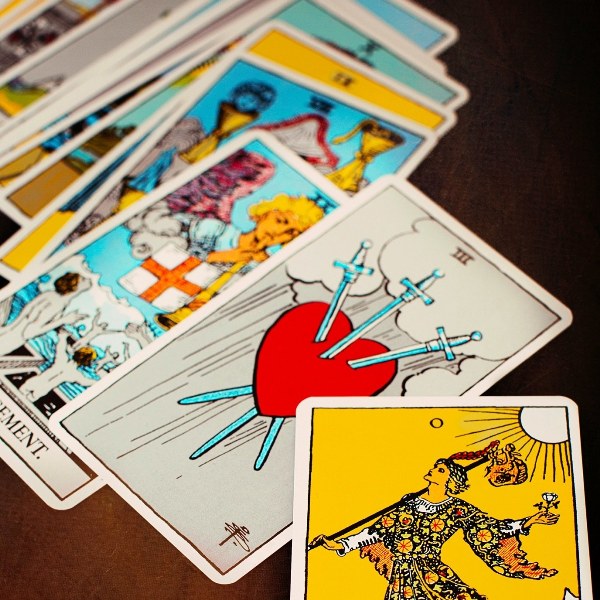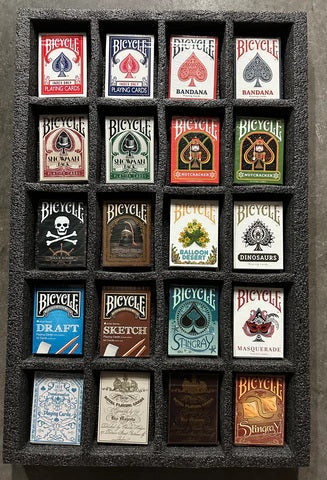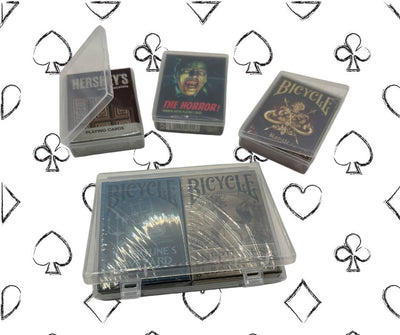by BoardGameGeek reviewer EndersGame
Claim: Playing cards developed from Tarot cards
You'll often come across the claim that our modern deck of playing cards was developed from the Tarot deck. Occultists and fortune tellers like to make the suggestion that Tarot decks are in fact the true and original form of playing cards, and that the symbolism of Tarot cards lies at the heart and background of our modern deck.
Some even defend the view that the Tarot deck represents a deck that was used by secret societies like the Masons or Knights Templar to transmit secret information. According to this interpretation, there are secrets within Tarot cards that go back to books and playing cards from ancient times that pre-date standard playing cards.
Fact: False
In reality, Tarot cards appear to have had a separate and much later origin than regular playing cards, possibly as a means of instruction and education, and certainly not first of all as a result of an interest in the occult or a usage for fortune-telling. The earliest surviving Tarot cards date from a period much later than regular playing cards, and the historical evidence supports their original use as additional trump cards. They consisted of 22 separate designs with allegorical illustrations that were added to a standard deck, in order to create a larger overall deck which was used first of all for gaming. As such they were initially part of a 78 card deck that was primarily used for more elaborate and complex games than was possible with a standard deck of 50+ cards. The symbolism and significance of the original illustrations from the era has been lost, and likely just reflects 15th century cultural fashions in Renaissance Italy. This means that present-day interpretations of these cards don't have an early historical basis.
Tarot cards were only used for cartomancy for the first time around 1750, which is more than a couple of centuries after the expanded tarot deck was first conceived and used for games. Fortune-telling with tarot cards was only popularized in the latter half of the 18th century, and the colourful images of the tarot cards did especially lend themselves well to this purpose. Jean-Baptiste Etteilla (a deliberate reversal of his actual name Alliette, to make it appear more mystical) was one of the first and most influential fortune tellers of the time, and is considered to be the first professional tarot occultist to make a living by card divination. He claimed that the tarot cards were linked to ancient Egypt, and he assigned esoteric meanings to them, many of which are still used today. Antoine Court, a French mason in the late 18th century, made similar claims that Tarot cards were derived the occultic Book of Thot, which supposedly originated in ancient Egypt, was the source of all knowledge, and was written by the Egyptian god of writing. Studying it was claimed to reveal secrets about humanity and keys to ancient knowledge.
Many modern day practitioners of the occult and voodoo continue to perpetuate the belief that the Tarot is embedded with secret symbols and images that hail back to ancient times, and that it gives answers, direction, and spiritual guidance. Particularly influential was Arthur Edward Waite, whose approach to the Tarot deck at the start of the 20th century would influence all subsequent Tarot playing cards. He was a member of an occultic society called the Hermetic Order of Golden Dawn, and the designs of the Ride-Waite Tarot that was first published in 1909 became in many ways a standard. Aleister Crowley's deck was painted over several years (1938-43) and was also very influential; it deliberately included many occultic elements, and some even find it disturbing.
Modern Tarot decks consist of 78 cards with two distinct parts. The Major Arcana (greater secrets) corresponds to the original 22 trump cards, and are numbered with Roman numerals from I to XXI, along with a Fool card. The Minor Arcana (lesser secrets) consists of 56 cards in four suits that are similar to the Italian swords, clubs, coins, and cups, although the clubs are typically called wands, rods or staves, while the coins are typically called pentacles or disks. Each suit has 14 cards, with four court cards accompanying ten number cards: King, Queen, Knight, and Page.
Despite its claims to be a tool to uncover the secrets of both past and future, it seems most likely that the Tarot is not a mystical key to the past, but rather that layers of meanings have been ascribed to it over time. Serious historians remain convinced that its origins lie in an innocent card game, and that occultists have bestowed it with a far greater significance than it ever had to begin with, adding meanings that were not present when the artists from the Renaissance painted the first Tarot cards. Academics like Michael Dummett have done extensive research on this topic and make a compelling case that the Tarot deck originated as popular trick-taking game in 15th century Italy, and that occultic interpretations were unknown prior to the 18th century. Even so, Tarot decks today are still popular. If nothing else they give artists and creative designers a larger canvas of cards to work with, resulting in some very artistically and beautiful designs.
Claim: Playing cards were invented in China
At some point you are almost certain to come across the often-repeated claim that the first playing cards were in China. It is a particularly common assertion that you will find online in basic and simplified articles about the origin of playing cards. And we all know that everything on the internet is true, right?
Certainly there is some historical evidence that points in the direction of supporting this claim. China is where paper and printing was first invented, and it's also where we find games like dominoes and mahjong, which bear some resemblance to playing cards. So it's not surprising to discover that an early ancestor of playing cards did exist in China. But were playing cards actually invented there?
Fact: Uncertain
The reality is that we can't be sure. Certainly it appears to be a real possibility that playing cards were invented in China during the Tang dynasty around the 9th century AD, as some believe. There is some evidence that games involving cards in some way were used in this time, although we can't be sure whether these cards functioned as currency for other games, as stakes for gambling, or whether they served as the game itself. But if playing cards did originate during this time, possibly from or alongside tile games like dominoes and mahjong, it would mean that they have their first beginnings prior to 1000AD. From China, playing cards would have proceeded west via India and Egypt, and eventually made their way to Europe.
But it is also possible that playing cards were invented in Persia, and from there spread east to places like China and Korea, and only then west to Europe. Historians really can't be sure, because paper is a very fragile product, so there's very little evidence that has survived the centuries and which we can reliably go by.
Playing cards unique to the native Americans of the 18th and 19th century also exist, with colours, suits, and icons that are derived from their own culture, and manufactured on rawhide and horse skins. Does that mean that they also invented playing cards? Not at all, because it is obvious that they just adapted an existing concept that was brought over to America from Europe by the early settlers. In most cases these native American decks were simply adaptations of existing Spanish decks they had already been introduced to. It is not impossible that the same happened with Chinese decks, which may actually have originated elsewhere.
What does appear to be certain is the striking resemblance between the first playing cards that emerged in Europe in the late 14th century and those used in Egypt prior to this. Playing cards first appeared in Italy in the late 1300s, and the four suits used there (cups, coins, swords, and clubs) are a close match to the goblets (cups), gold coins, swords, and polo-sticks found on playing cards used in Egypt during the Mamluk period.
But while playing cards appear to have made their way into Europe via Mamluk Egypt, this still doesn't establish their origin. In fact, in his book about the history of playing cards, Roger Tilley argues that it is even possible that playing cards in Europe had an altogether independent development. Perhaps we will never know where they first emerged on the pages of history, although once we get to the 14th century onwards in Europe, there is ample evidence about their function in society and culture.
With the absence of solid historical evidence, we may never be entirely certain about the precise origin of playing cards, although it does seem likely to have been in somewhere in the East, with China being at best a strong candidate. Unfortunately inaccurate information can easily acquire a life of its own in our internet age, and the oft-repeated claim that playing cards originated in China reflects a rather simplistic interpretation of the facts, that while undoubtedly well-intentioned and having some basis, remains to be proven. While we can't thank the unidentified ancestors that bequeathed us with playing cards today, we certainly can thank the many modern designers, publishers, retailers that are building on the foundation inherited from the past, and are giving us wonderful playing cards to enjoy today!
Where to get them? Check the range of Tarot decks and Vintage decks on Playing Card decks here:
Tarot decks: Like common playing cards, the tarot has four suits, but each consists of 14 cards, numbered from one to ten and four court cards. In addition there is a separate 21 card trump suit and a Fool card. Tarot cards are still used today to play card games, and since the late 18th century have also been used for fortune telling.
Vintage decks: These include custom and replica playing cards with a vintage or distressed look. As you can imagine, any decks actually from the 19th century and earlier are very rare, and are typically worth large sums of money. Fortunately you can purchase a beautiful slice of history without spending big bucks by picking up high quality replicas of some of decks produced in the US in the 19th century, or even decks that have a distressed and worn look. Many decks are available that have a very vintage look, and yet are produced with high quality cards by USPCC, so they handle beautifully.
Other articles you might find interesting:
- The History of Playing Cards: The Evolution of the Modern Deck
- Historical Curiosities That Shaped Our Modern Deck #1
- Historical Curiosities That Shaped Our Modern Deck #2
About the writer: EndersGame is a well-known and highly respected reviewer of board games and playing cards. He loves card games, card magic, cardistry, and card collecting, and has reviewed several hundred boardgames and hundreds of different decks of playing cards. You can see a complete list of his game reviews here, and his playing card reviews here. He is considered an authority on playing cards and has written extensively about their design, history, and function, and has many contacts within the playing card and board game industries. You can view his previous articles about playing cards here. In his spare time he also volunteers with local youth to teach them the art of cardistry and card magic.






1 comment
Are you serious? Playing cards♥️♠️♣️♦️ existed way before tarot. The major arcana cards of playing cards are of actual rulers